|
Lanzhou Lily -
[Lilium davidii var unicolor]
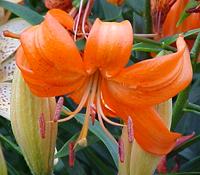
This lily is native to mountainous regions from northwestern China
south as far as Yunan. They are also found in the far northeastern
tribal regions of India as well as Bhutan and Tibet. This lily,
growing to about 5 feet tall, produces crisp sweet edible bulbs
up to 1-3/4 inches diameter. These are used in stir fries and in
various other ways. The flowers are not aromatic, so are not used
for food. The center for cultivation of this lily is around the city
of Lanzhou in the Gansu province of northwest China. This is
not the lily used to make dried lily buds called
"Golden Needles". That one
is actually in the Asparagus order.
Photo by Darm Crook Contributed to the Public Domain
.
Details and Cooking.
Calochortus (Genus) -
[Mariposa lilies, Globe lilies, Fairy lanterns, Cat's ears,
Star tulips; Calochortus]
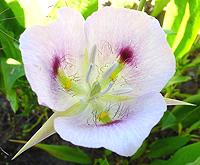
This genus of more than 70 species is native to North America, mostly
in the U.S. Western States. The bulbs of may species were important to
the American Indians, eaten both raw and cooked, and young flower buds
were also eaten. The bulbs were also eaten by early Mormon settlers in
Utah during times of crop failure. They aren't much eaten now, so I
have no information on how they taste.
Photo by Noah Elhardt distributed under license Creative
Commons
Attribution-ShareAlike v3.0 Unported.
Katakuri - [Erythronium japonicum]

This Trout Lily is native to Japan, Korea, the Russian Far East and
northeastern China, but is best known in Japan. It produces a small
root tuber about 3/8 inches in diameter and 2-3/8 inches long, from
which was made a starch powder called katakuriko. The starch
used today as "katakuriko" is usually potato starch, because the real
thing would be prohibitively expensive. The Katakuri lily is getting
very scarce. It propagates very slowly, taking 7 to 8 years before it
flowers. It is not farmed, but is subject to poaching, not for starch
these days, but for sale to wild flower enthusiasts.
Photo by Kropsoq distributed under license Creative
Commons
Attribution-ShareAlike v3.0 Unported.
Twisted Stalk -
[clasping twistedstalk, Watermelon berry. Scoot berries;
Streptopus amplexifolius]
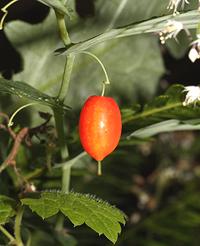
This herbaceous plant grows to 39 inches high. It is identifiable by
its stems being kinked at each leaf, and a kink in the flower stem
which remains with the fruit (see photo). It is native to the northern
United States, including Alaska, western Canada, Greenland, Europe
from Spain to Ukraine and as far north as Poland. It is also found
in East Asia and Eastern Russia.
Tender young shoots taste similar to cucumber and were eaten as
raw greens by American Indians in eastern North America. The juicy
berries, tasting much like watermelon, are also eaten, but have a
mildly laxative effect, thus the name "Scoot Berries". When young,
this plant resembles plants of the highly toxic Veratrim
genus, so should not be eaten unless identification is positive.
Photo by Walter Siegmund distributed under license Creative
Commons
Attribution-ShareAlike v3.0 Unported.
Indian Cucumber -
[Indian Cucumber-Root; Medeola virginiana]
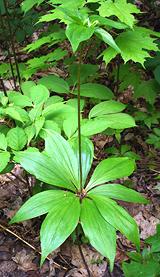
Native to North America from Minnesota to the Atlantic including
eastern Canada, and as far south as Florida, this plant grows to 30
inches high with one or two tiers of leaves. It is reported to be
naturalized in Bermuda. Only two tier plants have flowers. The lower
tier leaves are from 2-1/2 to 5 inches long.
The berries of this plant are not edible, but the crisp root tuber
is, and smells and tastes like cucumber. This plant is now rather
scarce, so eating it is to be discouraged.
Photo by Percor distributed under license Creative
Commons
Attribution-ShareAlike v3.0 Unported.
| 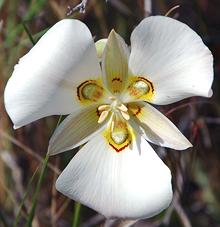 Liliales - Order
Liliales - Order Liliales - Order
Liliales - Order
